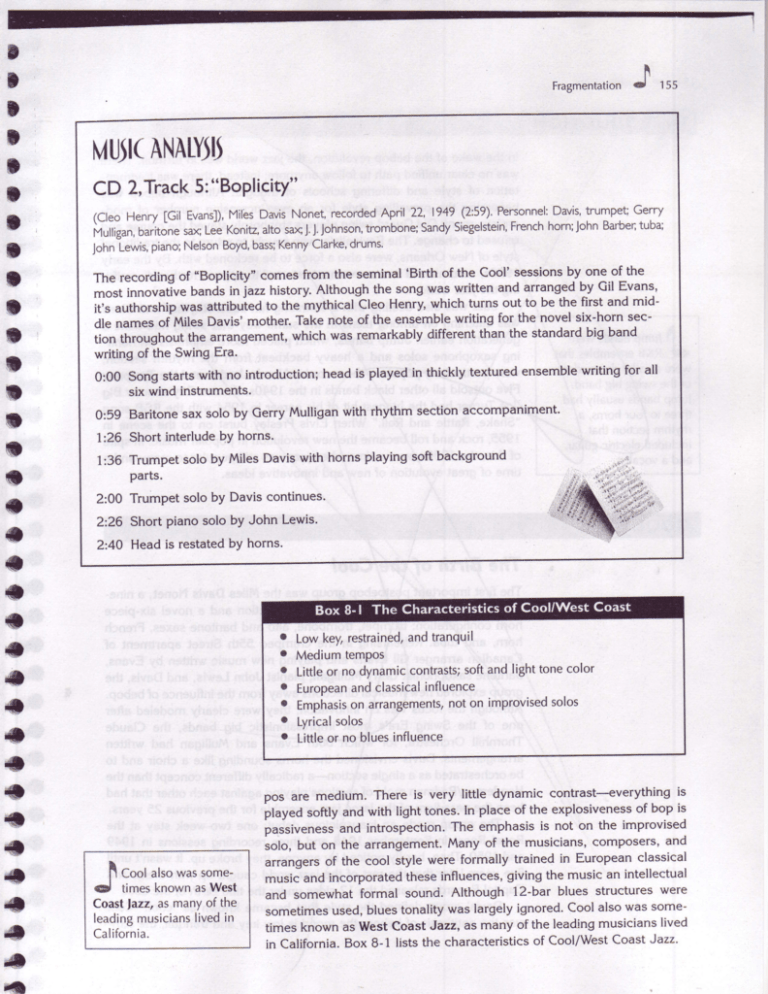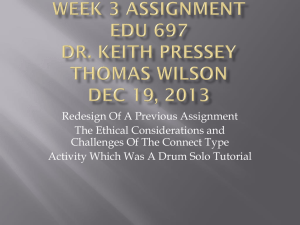o o o o o o e e a MUJt( ANALYJ|J
advertisement

t
t
I
D
t
D
D
t
o
t
o
o
t
o
o
o
(D
{D
(D
C
il
Fragmentationd
n
155
ANALYJ|J
MUJt(
"BoPlicitY"
CD Z,Track5:
Davis,trumpet;Gerry
Mil'esDavisNonet,recordedApril 22, 1949(2:59).Personnel:
(Cleo Henry [Gil Evans]),
tuba;
Badren
horn;John
French
trombone;sandysiegelstein,
J,Johnson,
baritone,u*; 1"" Koni?,ahosax;J.
Mulligan,
drums'
JohnLewis,piano;NelsonBoyd,bass;KennyClarke,
,,Boplicity" comes from the seminal 'Birth of the Cool' sessionsby one of the
The recording of
arranged by Gil Evans,
most innovatiue balds injazz history. Although the song was written and
be the first and midit,s authorship was attribuied to the mythical Cleo Henry, which turns out to
novel six-horn secdle names of Mll"r Davis' mother. Take note of the ensemble writing for the
standard big band
tion throughout the arrangement,which was remarkably different than the
writing of the Swing Era.
writing for all
0:00 Song starts with no introduction; head is played in thickly textured ensemble
six wind instruments.
0:59 Baritone sax solo by Gerry Mulligan with rhythm section accompaniment.
1:26 Short interludebY horns.
1:36 Trumpet solo by Miles Davis with horns playing soft background
parts.
2:00 Trumpet solo by Davis continues.
2:26 Short piano solo bY John Lewis.
2:40 Head is restaied bY horns.
a
a
a
t
a
o
a
o
fl
e
e
and tranquil
Low key,restrained,
Mediumtempos
softand lighttone color
Littleor no dynamiccontrasts;
influence
classical
and
European
not on improvisedsolos
on arrangements,
Emphasis
Lyricalsolos
Littleor no bluesinfluence
*
*
a
t
*
*
*
€
Cool alsowassometimesknown asWest
Coastlazz, as manyof the
livedin
leadingmusicians
California.
pos are medium. There is very little dynarnic contrast-everything is
ptayea softly and with light tones. In place of the explosivenessof bop is
pasri,reles" and introspection. The emphasis is not on the improvised
solo, but on the arrangement. Many of the musicians, composers, and
arrangers of the cool style were formally trained in European classical
music and incorporated these influences, giving the music an intellectual
and somewhat formal sound. Although 12-bar blues structures were
sometimesused,blues tonality was largely ignored.Cool also was sometimes known as West Coast Jazz, as many of the leadingmusicianslived
in California.Box 8-1 lists the characteristicsof Cool/WestCoast Jazz'








